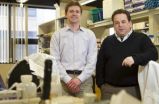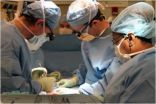(Press-News.org) TORONTO, March 21, 2013—Homeless people and their health care providers need to know more about traumatic brain injuries to help prevent and treat such injuries, a new study has found.
Homeless people have a disproportionately higher risk for TBI compared to the general population, yet little is known about the severity of those injuries, who exactly is suffering from them and what the long-term consequences are.
"A better understanding of TBI, its presentation and characteristics in the homeless is vital in order to enable appropriate interventions, treatments, and case management in the improvement of outcomes for this important segment of the population," said Dr. Jane Topolovec-Vranic, a clinical researcher in the Trauma and Neurosurgery Program at St. Michael's Hospital.
"Reducing the prevalence of homelessness and the incidence of injury and illness among people who are homeless would have significant financial, societal and individual implications."
Recent research has identified high rates of TBI among homeless people, but there has been no detailed review of existing data. Dr. Topolovec-Vranic and her colleagues in the Head Injury Clinic at St. Michael's Hospital reviewed all the recent scientific studies on homelessness and traumatic brain injuries to identify the gaps in knowledge and suggest areas of future research. Their findings were published recently in the journal BMC Public Health.
As many as one in nine Canadians have experienced homelessness or come close to it. Previous research has found that homeless people often suffer from serious health conditions, use the most expensive medical interventions such as emergency rooms, require longer hospital stays than people with homes and are at increased risk of death.
The studies Dr. Topolovec-Vranic and her team reviewed found that anywhere between 8 and 53 per cent of homeless people–mostly men--have traumatic brain injuries. The majority suffered a TBI before becoming homeless, suggesting TBI might be a risk factor for homelessness. It's also possible that impulse control disorders, for example, could predispose individuals to both TBI and homelessness, she said.
Traumatic brain injuries are caused by a blow or jolt to the head or a penetrating head injury that disrupts the function of the brain. The severity can range from mild, characterized by a brief change in mental status, to severe, which could include unconsciousness or amnesia. TBI is associated with low subsequent employment rates, which can contribute to a downward spiral into homelessness.
"It is also suggested that in the homeless population, cognitive impairment may increase the risk of remaining homeless, illustrating the potential for TBIs to contribute to the chronicity of homelessness," Dr. Topolovec-Vranic said.
###
About St. Michael's Hospital
St Michael's Hospital provides compassionate care to all who enter its doors. The hospital also provides outstanding medical education to future health care professionals in more than 23 academic disciplines. Critical care and trauma, heart disease, neurosurgery, diabetes, cancer care, care of the homeless and global health is among the Hospital's recognized areas of expertise. Through the Keenan Research Centre and the Li Ka Shing International Healthcare Education Center, which make up the Li Ka Shing Knowledge Institute, research and education at St. Michael's Hospital are recognized and make an impact around the world. Founded in 1892, the hospital is fully affiliated with the University of Toronto.
For more information, contact:
Leslie Shepherd
Manager, Media Strategy
Communications and Public Affairs Department
St. Michael's Hospital
Inspired Care. Inspiring Science. END
Exploring the link between traumatic brain injury and people who are homeless
Homeless people have a disproportionately higher risk for TBI compared to the general population
2013-03-21
ELSE PRESS RELEASES FROM THIS DATE:
Dysfunction in cerebellar Calcium channel causes motor disorders and epilepsy
2013-03-21
A dysfunction of a certain Calcium channel, the so called P/Q-type channel, in neurons of the cerebellum is sufficient to cause different motor diseases as well as a special type of epilepsy. This is reported by the research team of Dr. Melanie Mark and Prof. Dr. Stefan Herlitze from the Ruhr-Universität Bochum. They investigated mice that lacked the ion channel of the P/Q-type in the modulatory input neurons of the cerebellum. "We expect that our results will contribute to the development of treatments for in particular children and young adults suffering from absence ...
Misregulated genes may have big autism role
2013-03-21
PROVIDENCE, R.I. [Brown University] — A new study finds that two genes individually associated with rare autism-related disorders are also jointly linked to more general forms of autism. The finding suggests a new genetic pathway to investigate in general autism research.
The genes encode the proteins NHE6 and NHE9, which are responsible for biochemical exchanges in the endosomes of cells. Mutations in the NHE6 gene are a direct cause of Christianson Syndrome, while mutations in the NHE9 gene lead to a severe form of autism with epilepsy. In the new study, a statistical ...
Planck's 'child' universe
2013-03-21
"We are very excited, we are finally seeing the concrete results of so many years of hard work". This is how the scientists of the Planck project have commented the first data resulting from the observations carried out by Planck. The mission of the ESA satellite is to observe the past of our Universe, going back in time and reaching the very first instant right after the Big Bang. The image that the Planck scientists convey today is that of a 'child' Universe, dating back to about 380,000 years after the Big Bang, when its temperature was similar to that of the most external ...
Genetic analysis calls for the protection of 2 highly endangered Portuguese fish species
2013-03-21
The two endangered fish species, Squalius aradensis and S. torgalensis, most generally belong to the Cyprinidae, or the carp family. This is the largest fish, and vertebrate family, formed of freshwater fish with a diversity of more than 2,400 species. The family also has an important economic value as a food source. More specifically, the two species studied are members of the subfamily Leuciscinae, formed of small freshwater fish commonly known as minnows. A new genetic study of the two endangered fish was recently published in the open access journal Comparative Cytogenetics.
S. ...
Genetics, age and ethnicity are risk factors in PCa, say experts
2013-03-21
"Are there genetic risk factors for PCa? Yes, and BRCA2 and HOXB13 are useful for predicting high-risk disease," said Jack Cuzick (GB) president of the International Society for Cancer Prevention (ISCaP), referring to the two genes implicated in high-risk prostate disease. Cuzick gave a report on the Consensus Statement for Prostate Cancer Prevention at the closing plenary session of the 28 Annual EAU Congress held in Milan, Italy from March 15 to 19.
"The goal should be to integrate with other protein markers in order to develop risk-adapted screening algorithms," he ...
Novel insights into the evolution of protein networks
2013-03-21
This press release is available in German.
System-wide networks of proteins are indispensable for organisms. Function and evolution of these networks are among the most fascinating research questions in biology. Bioinformatician Thomas Rattei, University of Vienna, and physicist Hernan Makse, City University New York (CUNY), have reconstructed ancestral protein networks. The results are of high interest not only for evolutionary research but also for the interpretation of genome sequence data. Recently, the researchers published their paper in the renowned journal PLOS ...
Planck challenges our understanding of the Universe
2013-03-21
Planck refines our knowledge of the Universe's composition and evolution
New maps provide excellent evidence for our standard model of cosmology
Planck dates Universe at 13.82 billion years old
Anomalies suggest that Universe may be different on scales larger than those we can directly observe
Most accurate values yet for the ingredients of the Universe, with normal matter contributing just 4.9% of the mass/energy density of the Universe and dark matter making up 26.8% - nearly a fifth more than the previous estimate.
Europe's Planck satellite - a flagship mission ...
What you eat before surgery may affect your recovery
2013-03-21
BOSTON, MA—According to a new study, the last few meals before surgery might make a difference in recovery after surgery. Fat tissue is one of the most dominant components that make up the body, and fat tissue is always traumatized during major surgery.
Researchers at Brigham and Women's Hospital (BWH) found that this direct trauma greatly impacts the chemical balance of fat tissue—chemicals that are known to communicate with nearby and distant organs. In the study, mice that consumed a typical Western, high-fat diet showed an exaggerated imbalanced response. Importantly, ...
Researchers tackle physician challenge of correctly ordering laboratory tests
2013-03-21
(Boston) – A new study involving researchers from the Boston University School of Medicine (BUSM) has identified barriers that clinicians face in correctly ordering appropriate laboratory tests and highlights some solutions that may simplify this process and improve patient outcomes. The study, published in the March 2013 issue of the Journal of General Internal Medicine, was led by Elissa Passiment, EdM, of the American Society for Clinical Laboratory Science and James L. Meisel, MD, associate professor of medicine at BUSM.
Passiment, Meisel and colleagues identified ...
Global nitrogen availability consistent for past 500 years, linked to carbon levels
2013-03-21
MANHATTAN -- A Kansas State University research team has found that despite humans increasing nitrogen production through industrialization, nitrogen availability in many ecosystems has remained steady for the past 500 years. Their work appears in the journal Nature.
"People have been really interested in nitrogen in current times because it's a major pollutant," said Kendra McLauchlan, assistant professor of geography and director of the university's Paleoenvironmental Laboratory. "Humans are producing a lot more nitrogen than in the past for use as crop fertilizer, ...
LAST 30 PRESS RELEASES:
Reducing social isolation protects the brain in later life
Keeping the heart healthy increases longevity even after cancer
Young adults commonly mix cannabis with nicotine and tobacco
Comprehensive review illuminates tau protein's dual nature in brain health, disease, and emerging psychiatric connections
Book prepares K-12 leaders for the next public health crisis
Storms in the Southern Ocean mitigates global warming
Seals on the move: Research reveals key data for offshore development and international ecology
Sports injuries sustained during your period might be more severe
World's first successful 2 Tbit/s free-space optical communication using small optical terminals mountable on satellites and HAPS
Can intimate relationships affect your heart? New study says ‘yes’
Scalable and healable gradient textiles for multi‑scenario radiative cooling via bicomponent blow spinning
Research shows informed traders never let a good climate crisis go to waste
Intelligent XGBoost framework enhances asphalt pavement skid resistance assessment
Dual-function biomaterials for postoperative osteosarcoma: Tumor suppression and bone regeneration
New framework reveals where transport emissions concentrate in Singapore
NTP-enhanced lattice oxygen activation in Ce-Co catalysts for low-temperature soot combustion
Synergistic interface engineering in Cu-Zn-Ce catalysts for efficient CO2 hydrogenation to methanol
COVID-19 leaves a lasting mark on the human brain
Scientists use ultrasound to soften and treat cancer tumors without damaging healthy tissue
Community swimming program for Black youth boosts skills, sense of belonging, study finds
Specific depressive symptoms in midlife linked to increased dementia risk
An ‘illuminating’ design sheds light on cholesterol
Who is more likely to get long COVID?
Study showcases resilience and rapid growth of “living rocks”
Naval Research Lab diver earns Office of Naval Research 2025 Sailor of the Year
New Mayo-led study establishes practical definition for rapidly progressive dementia
Fossil fuel industry’s “climate false solutions” reinforce its power and aggravate environmental injustice
Researchers reveal bias in a widely used measure of algorithm performance
Alcohol causes cancer. A study from IOCB Prague confirms damage to DNA and shows how cells defend against it
Hidden viruses in wastewater treatment may shape public health risks, study finds
[Press-News.org] Exploring the link between traumatic brain injury and people who are homelessHomeless people have a disproportionately higher risk for TBI compared to the general population




